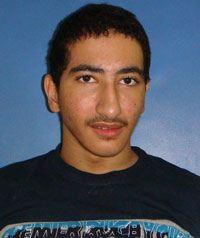Al Khatab Yahya -Friedreich Ataxia (Oman) Post on August 19, 2011
Name: Al Khatab Yahya 
Sex: Male
Country: Oman
Age: 14
Diagnoses: Friedreich Ataxia, epilepsy
Admission Date: 2011-07-05
Days Admitted to the Hospital: 31
Al Khatab Yahya was healthy before the onset of the disease. He started walking when he was 1 and a half years old and the gait was normal. He was still able to walk at the age of 5, but his gait became unstable. The symptoms progressed gradually and he developed weakness in the limbs and began walking slowly, eventually leading to his inability to walk unassisted. Other symptoms included difficulty swallowing and paroxysmal epileptic seizures which occurred several times per day. The seizures lasted for several seconds each time, but did not lead to unconsciousness or excessive salivation. He received an MRI of the head at the local hospital and the results showed unusual amounts of white matter. He was diagnosed with Friedreich ataxia. The walking posture and gait were abnormal and there was contracture deformity in both knees and ankle joints. Al Khatab has one brother and one sister who suffer from the same disease.
Al Khatab's parents looked for treatment options and came upon our medical center's website and after consulting with the doctors, made the decision to come to our medical center for treatment.
The admission examination revealed that Al Khatab's diet was poor and he was thin. He had abnormal posture and both knees were flexed in the adduction position. There was spinal deformity. The muscle volume of all four limbs was poor.
Al Khatab was able to do sit-ups, but at a slow pace. He couldn't walk independently and needed some assistance. The walking gait was duck-like.
During the examination of the nervous system, Al Khatab was alert, and he was in good spirits. His speech was not clear and he spoke slowly. His memory, calculation abilities and orientation were all normal. Both eyeballs could move freely and the pupils were sensitive to light stimulus. There was horizontal nystagmus. The ability to close his right eye was strong, but the left eye was weaker. The tongue was averted to the right side and the mouth was averted to the left side. The temporalis and masseter muscles were weak. The right side of the face was fuller than the left side. The left cheek had air leakage when the cheeks were expanded. The muscle strength of the soft palate was strong. The shoulders could swivel and shrug powerfully. The muscle strength of the right arm was level 5- and the holding power of the right hand was level 5. The muscle strength of the left arm was level 4+ and the holding power of the left hand was level 5-. The muscle strength of the right leg was level 3-. The muscle strength of the left leg was level 3. The muscle tone of both arms was almost normal. The muscle tone of the inner thighs was increased slightly. The bilateral triceps reflex, biceps reflex and radial periosteal reflex were normal. The bilateral patellar tendon reflex was positive. The bilateral suprapatellar reflex was active, the Achilles tendon had hyper reflexive activity, the ankle clonus was positive. The abdominal reflex was elicited normally. The deep, shallow, and fine sensations were normal through loose measure. The bilateral sucking reflex and jaw reflex were negative. The bilateral palm jaw reflex was negative. The bilateral Hoffmann's sign was negative, the bilateral Babinski's sign was positive. The left side could finish the digital opposition test and the rapid rotation test slowly and in an unstable way. The right side performed better than the left side. Al Khatab couldn't finish the heel-knee-shin test. The Romberg's test was positive.
We initially gave Al Khatab a complete examination. After the diagnoses of Friedreich's Ataxia and epilepsy, he was given treatment to improve the blood circulation to increase the blood supply to the damaged neurons. He also received treatment to nourish the nerves and promote the repair of the nerves. This was combined with daily physical rehabilitation treatment.
After the completion of the treatment, the epileptic seizures decreased. The horizontal nystagmus had been alleviated. The muscle strength of the masseter and temporalis muscles became stronger than before. The air leakage in the left cheek has noticeably decreased when the cheeks are expanded. The movement of the tongue is more flexible than before. The muscle strength of the arms is now level 5; the muscle strength of the legs is level 4. Before the treatment, Al Khatab had to bend down half way to relieve the pressure on the knees but now this condition has been alleviated. He can now point his thumbs to the other fingers in a more flexible way.
The entire staff of Wu Stem Cells Medical Center hopes that Al Khatab continues making solid improvements.
